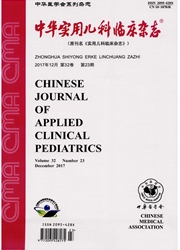

 中文摘要:
中文摘要:
【摘要】目的探讨新疆伊犁地区正常体质量及超体质量/肥胖学龄儿童6种常见肠道菌属的分布特征。方法根据纳入标准选取150例学龄儿童(年龄7—13岁),按体质量指数(BMI)分为正常体质量组(75例)和超体质量/肥胖组(75例),2组均采集大便,采用16SrRNA荧光定量聚合酶链反应方法测定大便样本中6种肠道菌属的分布,并分析种族、性别及年龄对肠道菌属分布的影响。结果2组间除BMI、腰围分布差异有统计学意义外(t=20.740、8.533,P均〈0.01),年龄、性别组成、民族分布、臀围差异均无统计学意义(P均〉0.05)。超体质量/肥胖组乳酸杆菌属、梭菌属及肠球菌属相对数量显著高于正常体质量儿童(t=9.735、9.681、26.070,P均〈0.01),埃希菌属、双歧杆菌属及拟杆菌属2组间比较,差异无统计学意义(P〉0.05)。依次按照种族、性别及年龄进行分层分析发现:除双歧杆菌属在女童中的表达略低于男童(t=4.931,P〈0.05)外,6种常见肠道菌属在不同民族、不同性别及不同年龄间的分布差异均无统计学意义(P均〉0.05)。结论新疆伊犁地区学龄儿童肠道菌属的分布受种族、性别及年龄影响小,但乳酸杆菌属、梭菌属及肠球菌属分布特征可能与学龄儿童肥胖发生密切相关。
 英文摘要:
英文摘要:
Objective To investigate intestinal bacteria genera distribution between normal weight and over- weight/obesity school-age children in Yili region of Xinjiang. Methods Selecting eligible 150 fecal samples from school-age children (aged from 7 to 13 years old), all samples were divided into normal weight group and overweight/o- besity group according to the body mass index ( BMI), and each group contained 75 samples. Fecal samples were collected and DNA was extracted, then 6 types of intestinal bacteria genera were detected by the quantitative real-time polymerase chain reaction. Results The distribution of age, gender, ethnicity and hip circumference between 2 groups had no statistically significance ( all P 〉 0. 05 ) , except that of BMI and waist circumference ( t = 20. 740,8. 533, all P 〈 0. O1 ). The concentration of Lactobacillus, Clostridium and Enterococcus were significantly higher in the obese/o- verweight children (t = 9. 735,9. 681,26. 070, all P 〈 O. O1 ), whereas no significant differences were found in the con- centration of Escherichia, Bifidobacterium and Bacteroides between 2 groups. According to the stratified analysis of eth- nicity, gender and age, there was no significant difference among Han, Kazakh and Uyghur children. While stratified by gender, Bifidobacterium was significantly lower in girls than that of boys ( t = 4.931, P 〈0. 05 ). The distribution of the 6 types of intestinal bacteria genera was no statistically significant among different ethnicity, gender and age groups. Conclusions The intestinal bacteria genera number distribution in different ethnicity, gender and age groups makes no sense. The 16SrRNA type number of the Lactobacillus,Clostridium and Enterococcus may be associated with childhood obesity.
 同期刊论文项目
同期刊论文项目
 同项目期刊论文
同项目期刊论文
 期刊信息
期刊信息
